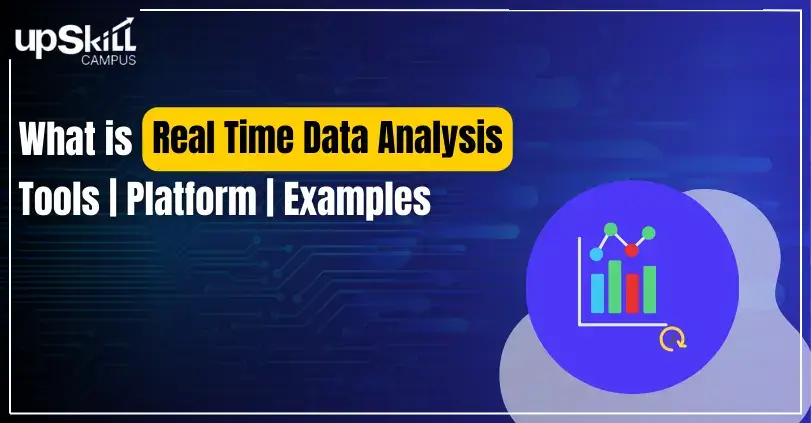Natural Language Processing - Explain the Role of NLP in Data Science

By Upskill Campus
Published Date: 15th July, 2024 Uploaded By: Shriyansh Tiwari
NLP stands for Natural Language Processing, an advanced field growing fast. It's where computers learn to understand and chat with us. As a result, it is becoming critical because there's more and more text data out there, and NLP helps us make sense of it all and even automate some tasks. The following article will explore all the primary concepts of NLP in data science.
What is NLP in Data Science?
NLP, or Natural Language Processing, is a field of computer science that uses advanced tools to analyze text and speech, almost like tricks for computers. In addition, this lets them understand what we're saying and even how we feel about it. Moreover, this skill unlocks a world of possibilities, from translating languages to recognizing our voices on the phone. NLP is like a secret bridge between us and computers, helping them understand us better.
NLP uses different tools to analyze text and speech. Moreover, this lets computers grasp what we're saying, including how we feel about it. This super skill lets computers do advanced things like translate languages, recognize our voices, and even write summaries. You might already use NLP in your daily life with voice GPS, chatbots, or that handy tool that turns your voice into text. NLP for data science makes computers understand us better and helps businesses work even smoother.
Natural Language Processing Types
Here, we have two types of NLP in data science. Follow and understand the below section to clear all your doubts.
- Rule-Based NLP: This is like the "rule book" method. The computer follows a set of pre-programmed instructions to understand what words mean and how they fit together in sentences. Moreover, it's acceptable for simple tasks but can struggle with complex language.
- Statistical NLP: This is like the "learning by example" method. The computer analyzes massive amounts of text data to learn the patterns of language itself. Moreover, this lets it handle more complex language, but it takes a lot of data to train effectively.
Both rule-based and statistical NLP have their uses, and data scientists choose the right approach based on the specific task.
Natural Language Processing Uses
Chatbots are like computer helpers who can chat with you online, answering your questions or solving problems. They're trained on multiple conversations. NLP, or Natural Language Processing, is the secret language that lets them understand you.
NLP in data science can also listen to immense online conversations, like on Twitter. By analyzing the words people use, NLP can tell if the feeling is positive, negative, or just neutral. Moreover, this is sentiment analysis, and it helps businesses understand how people feel about their products or ideas.
Other Use Cases of NLP are as follows:
- Finding all the names of people and companies in a giant document with words.
- NLP can sort them by topic so you can find the conversation you need immediately.
- NLP can also find mentions of people in online discussions, even if they aren't directly talking.
- Connecting things is another NLP superpower. It can link all the info about a topic online.
Working of NLP in Data Science
NLP or Natural Language Processing can chat with you and understand your meaning. It breaks down language into building blocks, like words and grammar, to make sense of what we say.
NLP goes through a few steps:
- First, NLP uses "text analytics" to understand the grammar, meaning, and purpose.
- Then, NLP uses different approaches to analyze the data.
- Statistician Approach: This method uses statistics to guess the meaning of words based on how they are used, like figuring out if it's a noun or a verb.
- Frame Builder: This approach uses a unique structure to understand sentences that can be phrased differently but mean the same thing.
- Interactive Teacher: This method involves you helping the computer learn language step-by-step, like training a new friend!
With NLP, computers are getting better at understanding our language every day. However, it opens up a world of possibilities, from chatbots that can answer your questions to machines that can analyze massive amounts of text data.
Natural Language Processing Benefits
Natural Language Processing in data science can handle big chunks of text data (like emails, reports, or social media posts) quickly and learn from it.
Here are some advantages of NLP for businesses:
- Faster insight discovery: NLP can unearth hidden patterns and connections in your text data, like trends in customer reviews or hidden insights in research papers. As a result, it helps you make smarter decisions and has new ideas.
- Ampler budget savings: There's a lot of text data out there, and sorting through it manually takes time and money. NLP can automate this process, meaning less work for your staff and more savings for you.
- Quick access to corporate data: NLP can help build this, allowing everyone (from sales reps to managers) to find what they need quickly, which means better customer service and more closed deals.
In short, NLP systems are like brainy assistants that can handle text data, saving you time and money and helping you make better decisions.
NLP Role in Data Science
Natural Language Processing is a unique skill that data scientists use to unlock the secrets hidden in giant piles of text data.
- NLP in data science removes punctuation and extra spaces, making it easier to analyze.
- Once the data is clean, NLP can sort it into categories. As a result, it puts all your toys in bins. For example, it can separate reviews into "positive" and "negative" piles.
- NLP analyzes text to see if the feeling is positive, negative, or neutral. However, it helps businesses understand their customers.
- It can find things like names, dates, or places buried in text.
- NLP isn't limited to just English. It can translate text from one language to another, breaking down communication barriers.
- NLP can generate realistic text, which is helpful for things like chatbots and automatic writing tools.
- It can analyze natural language queries and find you the information you need.
- NLP can take long pieces of text and shorten them into easy-to-read summaries. However, it is significant for things like news articles or research papers.
- NLP can even understand spoken words. Moreover, this lets machines translate speech to text, which uses voice assistants and dictation software.
- It can analyze social media posts to understand what people are feeling and talking about. Moreover, it helps businesses and organizations track their brand reputation.
Just like any powerful tool, NLP needs to be used carefully. Data scientists need to ensure the data they use is fair and unbiased.
Natural Language Processing Example
Data science is a toolbox with many advanced gadgets, and NLP (Natural Language Processing) is one of the most powerful. Moreover, it lets us unlock the secrets hidden in massive piles of text data, like emails, social media posts, or articles.
Here are some real-world examples:
- Spam Filter: A data science team builds a program that reads emails and learns to identify spam based on the words and phrases used. As a result, this keeps your inbox clean.
- Stock Market Insights: Data scientists use NLP to scan news articles and identify significant financial information. In addition, it helps them understand what's happening in the market and make better investment decisions.
- Happy or Angry Customers: An online store uses NLP to analyze customer reviews. Moreover, it helps them see if customers are happy or unhappy and what can be done to improve their experience.
In short, NLP is a powerful tool that helps data scientists understand the world around them by making sense of big text data.
Conclusion
NLP in data science is a translator, unlocking the secrets hidden in massive amounts of text. In addition, it can sort through emails, social media posts, articles, and more to find patterns, feelings, and essential details. Moreover, it helps data scientists understand customer sentiment, track trends, summarize information, and even build machines that can chat and translate languages. NLP is a powerful tool that's constantly evolving, and it's helping data science make sense of our ever-growing digital world.
Frequently Asked Questions
Q1.Is NLP in Python?
Ans. Yes, NLP can be implemented in Python using libraries like NLTK, spaCy, TextBlob, Gensim, and Transformers.
Q2.What does NLP mean in programming?
Ans. Natural language processing (NLP) is an ML technology that allows computers to analyze, comprehend, and manipulate human language.
About the Author
UpskillCampus provides career assistance facilities not only with their courses but with their applications from Salary builder to Career assistance, they also help School students with what an individual needs to opt for a better career.





Leave a comment